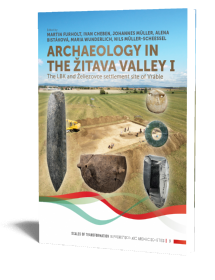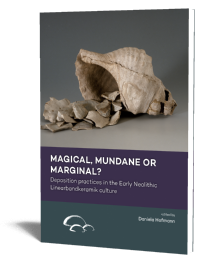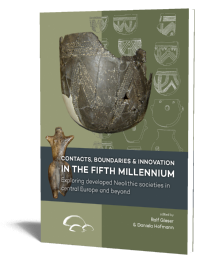Neu (im) Land – erste Bäuer:innen in der Peripherie
Der linienbandkeramische Fundplatz Lietzow 10 im Havelland, Brandenburg
Edited by Wiebke Kirleis, Andrea Hahn-Weishaupt, Mara Weinelt & Susanne Jahns | 2024
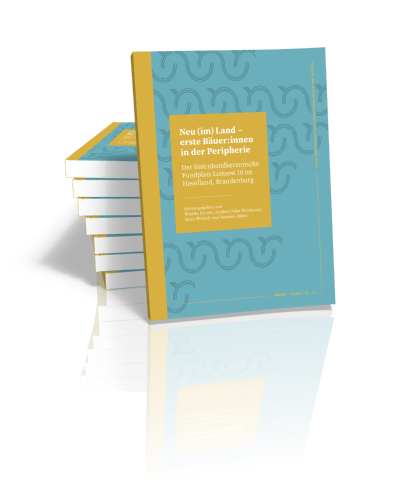
Neu (im) Land – erste Bäuer:innen in der Peripherie
Der linienbandkeramische Fundplatz Lietzow 10 im Havelland, Brandenburg
Edited by Wiebke Kirleis, Andrea Hahn-Weishaupt, Mara Weinelt & Susanne Jahns | 2024
Paperback ISBN: 9789464270877 | Hardback ISBN: 9789464270884 | Imprint: Sidestone Press Academics | Format: 210x280mm | 154 pp. | ROOTS Studies 05 | Series: ROOTS Studies | Language: German | 14 illus. (bw) | 32 illus. (fc) | Keywords: Linear Pottery; periphery; Brandenburg; settlement archaeology; archaeobotany; archaeozoology; ceramics; stone artefacts, radiocarbon dates; LBK; Neolithic | download cover | DOI: 10.59641/w0033zi
Read online or downloaded 680 times
-
Digital & Online access
This is a full Open Access publication, click below to buy in print, browse, or download for free.
-
Buy via Sidestone (EU & UK)
-
Buy via our Distributors (WORLD)
For non-EU or UK destinations you can buy our books via our international distributors. Although prices may vary this will ensure speedy delivery and reduction in shipping costs or import tax. But you can also order with us directly via the module above.
UK international distributor
USA international distributor
-
Bookinfo
Paperback ISBN: 9789464270877 | Hardback ISBN: 9789464270884 | Imprint: Sidestone Press Academics | Format: 210x280mm | 154 pp. | ROOTS Studies 05 | Series: ROOTS Studies | Language: German | 14 illus. (bw) | 32 illus. (fc) | Keywords: Linear Pottery; periphery; Brandenburg; settlement archaeology; archaeobotany; archaeozoology; ceramics; stone artefacts, radiocarbon dates; LBK; Neolithic | download cover | DOI: 10.59641/w0033zi
Read online or downloaded 680 times

We will plant a tree for each order containing a paperback or hardback book via OneTreePlanted.org.
Bei einer Ausgrabung im havelländischen Lietzow in Brandenburg wurden jungsteinzeitliche Siedlungsbefunde entdeckt. Sie gehören zu zwei Hofstellen der jüngeren Linienbandkeramik, die um 5100-5000 v. u. Z. datiert. Die in der äußersten Peripherie des damaligen bäuerlichen Siedlungsgebiets gelegene Siedlung Lietzow 10 bestand über ungefähr zwei Generationen. Die von dichtem Eichen-Kiefernwald umgebene Siedlung lag wie eine kleine Insel auf einer Grundmoränenplatte, die mit relativ fruchtbarem Boden und guter Grundwasserversorgung einen günstigen Standort für eine bäuerliche Existenz bot. Die nahen Niederungsgebiete waren zur gleichen Zeit von mesolithischen Wildbeutergruppen bewohnt.
Die Analysen der zahlreichen Tier- und Pflanzenreste von Lietzow 10 zeigen das Bild einer voll entwickelten neolithischen Landwirtschaft mit dem Rind als wichtigstem Nutztier und Emmer als Hauptgetreide. Fischfang und wohl auch Sammelwirtschaft trugen in größerem Umfang zur Nahrungssicherung bei. Die Jagd spielte nur eine untergeordnete Rolle.
Trotz ihrer randlichen Lage war die Siedlung aber keinesfalls isoliert. Der Großteil der Formen und Verzierungen des umfangreichen Keramikinventars zeigt deutlich den Einfluss aus dem mitteldeutschen Raum. Darüber hinaus sind weitreichende Fernbeziehungen bis Süddeutschland nachweisbar. Auch die Steinartefakte belegen Fernkontakte. Der Großteil der Steingeräte verweist auf ein regionales Netzwerk, da Flint und Mahlsteinrohstoff als Vollkerne von in einiger Entfernung zur Siedlung gelegenen Abbaustellen stammen. Hingegen fehlt ein eindeutiger Beweis für einen Austausch zwischen den mesolithischen und neolithischen Gruppen im Havelland.
English abstract
This publication presents research on the first peasants of the Linear Pottery group in Brandenburg, northern Germany. The region is of particular interest because it is situated in the absolute periphery of the Linear Pottery area. The volume combines the results on settlement features, pottery and stone tools with archaeobotanical and archaeozoological studies on the diet and economy of these Neolithic people with focus on the site of Lietzow 10. This holistic approach fulfils a research desideratum, because the state of knowledge about such enclaves of agricultural life in the midst of the settlement area of forager groups is still incomplete.
The excavation of the site Lietzow 10 yielded features from which a settlement site with two farmsteads could be reconstructed, which was inhabited for 2-3 generations. Large quantities of pottery were found, according to typology dating into the period around 5100 to 5000 BCE at the latest, i.e. to the younger LBK. Several radiocarbon dates support this chronological classification and confirm the Linear Pottery chronologies from Central Germany for Brandenburg features.
Despite its peripheral location, the settlement site was by no means isolated; the pottery finds even attest to long-distance contacts. The supply of raw material for the stone implements points to a regional network, for flint and grindstone raw material were not extracted in the vicinity of the site, but were apparently mined some distance away.
The archaeozoological and archaeobotanical investigations – for the latter, samples from other Neolithic settlements in Havelland were also available – provide insights into the economic practices and diet of the settlers. The cereals found were almost exclusively emmer, other crops were flax and pea. Animal husbandry was of outstanding importance for the food supply. Among the domestic animals, cattle probably played the greatest economic role, but pigs and small ruminants were also significant. Both, the crop and the domestic animal evidence show a fully developed agriculture. In addition, there is evidence for extensive gathering. Hunting – unlike fishing – did not play a major role in the diet, although wide range of game species is represented.
Foreword of the Series Editors
Vorwort der Reihenherausgeber:innen
Vorwort der Bandherausgeberinnen
Bandkeramische Gruppen in der nördlichen Peripherie der Kommunikation – eine Würdigung des spätlinienbandkeramischen Fundplatzes Lietzow 10 im Havelland, Brandenburg
Maha Ismail-Weber
Eine Siedlung der Linienbandkeramik an der Bundesstraße 5 in Lietzow. Der Fundplatz Lietzow 10, Lkr. Havelland, Brandenburg
Andrea Hahn-Weishaupt
Radiokarbon-Datierungen vom linienbandkeramischen Fundplatz Lietzow 10, Lkr. Havelland, Brandenburg
Mara Weinelt und Susanne Jahns
Die Keramik und die Dechselklinge vom linienbandkeramischen Fundplatz Lietzow 10, Lkr. Havelland, Brandenburg
Ralph Einicke
Steinartefakte und Schmuck von der linienbandkeramischen Fundstelle Lietzow 10, Lkr. Havelland, Brandenburg
Hans-Christoph Strien
Haustierhaltung, Jagd und Fischfang in der linienbandkeramischen Siedlung Lietzow 10, Lkr. Havelland, Brandenburg
Norbert Benecke und Susanne Hanik
Früher Ackerbau an der Peripherie – Die Pflanzenfunde neolithischer Fundplätze im Havelland, Brandenburg
Wiebke Kirleis, Susanne Jahns, Yasmin Dannath, Reinder Neef
Nachwort: Neu ins Land und was dann? Eine kurze Zusammenschau der Ergebnisse vom Fundplatz Lietzow 10 im Havelland, Brandenburg
Wiebke Kirleis, Susanne Jahns, Mara Weinelt, Andrea Hahn-Weishaupt
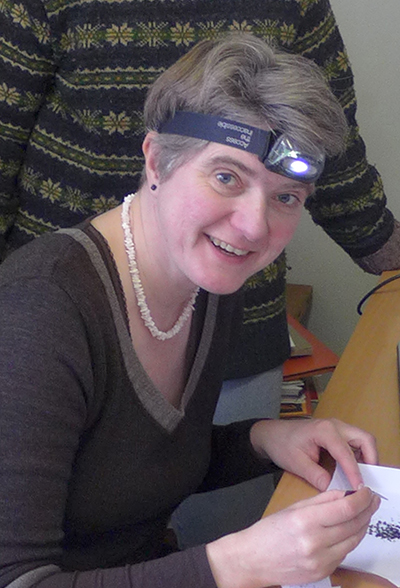
Prof. Dr. Wiebke Kirleis
Wiebke Kirleis is professor of environmental archaeology/archaeobotany at Kiel University, Germany. She is deputy director of the Collaborative Research Centre ‘Scales of Transformation: Human–Environmental Interaction in Prehistoric and Archaic Societies’ (CRC 1266, financed by the German Research Foundation/DFG) and a member of the Cluster of Excellence ‘Roots’ at Kiel University.
Susanne Jahns
Susanne Jahns worked as a palynologist at the University of Göttingen, where she studied sites in Croatia and Greece as well as cores from the Atlantic Ocean off Africa. In 1995, she began her palynological research in the state of Brandenburg at the German Archaeological Institute in Berlin and has been continuing it since 2000 at the Brandenburg State Office for Heritage Management and the Archaeological Museum in Wünsdorf.
Dr. Mara Weinelt
Mara Weinelt studied Geology and Paleontology at the University of Tübingen, earned a PhD and her habilitation in Paleooceanography at Kiel University, and is a senior scientist at the Institute of Prehistoric and Protohistoric Archaeology atKiel University since 2007. Her main research interest focuses on exploring the role of past climate change on Holocene socio-environments.
Andrea Hahn-Weishaupt
Andrea Hahn-Weishaupt studied prehistoric archaeology and human anthropology in Freiburg i.Br. and Tübingen. Since 1997, she has been running a successful archaeological excavation company in tandem with her husband, and in the interim, her daughter joined them as well. The company specialises in an extensive spectrum of archaeological pursuits, encompassing historical cemeteries, medieval village and town centres, prehistoric sites, and tangible remnants of the Nazi terror regime. Since 1998, she has been leading large-scale field inspections in the Uckermark, Brandenburg, as part of a job creation measure. In 2010, Andrea Hahn-Weishaupt joined the Archäologische Gesellschaft in Berlin und Brandenburg as a board member.
Abstract:
Bei einer Ausgrabung im havelländischen Lietzow in Brandenburg wurden jungsteinzeitliche Siedlungsbefunde entdeckt. Sie gehören zu zwei Hofstellen der jüngeren Linienbandkeramik, die um 5100-5000 v. u. Z. datiert. Die in der äußersten Peripherie des damaligen bäuerlichen Siedlungsgebiets gelegene Siedlung Lietzow 10 bestand über ungefähr zwei Generationen. Die von dichtem Eichen-Kiefernwald umgebene Siedlung lag wie eine kleine Insel auf einer Grundmoränenplatte, die mit relativ fruchtbarem Boden und guter Grundwasserversorgung einen günstigen Standort für eine bäuerliche Existenz bot. Die nahen Niederungsgebiete waren zur gleichen Zeit von mesolithischen Wildbeutergruppen bewohnt.
Die Analysen der zahlreichen Tier- und Pflanzenreste von Lietzow 10 zeigen das Bild einer voll entwickelten neolithischen Landwirtschaft mit dem Rind als wichtigstem Nutztier und Emmer als Hauptgetreide. Fischfang und wohl auch Sammelwirtschaft trugen in größerem Umfang zur Nahrungssicherung bei. Die Jagd spielte nur eine untergeordnete Rolle.
Trotz ihrer randlichen Lage war die Siedlung aber keinesfalls isoliert. Der Großteil der Formen und Verzierungen des umfangreichen Keramikinventars zeigt deutlich den Einfluss aus dem mitteldeutschen Raum. Darüber hinaus sind weitreichende Fernbeziehungen bis Süddeutschland nachweisbar. Auch die Steinartefakte belegen Fernkontakte. Der Großteil der Steingeräte verweist auf ein regionales Netzwerk, da Flint und Mahlsteinrohstoff als Vollkerne von in einiger Entfernung zur Siedlung gelegenen Abbaustellen stammen. Hingegen fehlt ein eindeutiger Beweis für einen Austausch zwischen den mesolithischen und neolithischen Gruppen im Havelland.
English abstract
This publication presents research on the first peasants of the Linear Pottery group in Brandenburg, northern Germany. The region is of particular interest because it is situated in the absolute periphery of the Linear Pottery area. The volume combines the results on settlement features, pottery and stone tools with archaeobotanical and archaeozoological studies on the diet and economy of these Neolithic people with focus on the site of Lietzow 10. This holistic approach fulfils a research desideratum, because the state of knowledge about such enclaves of agricultural life in the midst of the settlement area of forager groups is still incomplete.
The excavation of the site Lietzow 10 yielded features from which a settlement site with two farmsteads could be reconstructed, which was inhabited for 2-3 generations. Large quantities of pottery were found, according to typology dating into the period around 5100 to 5000 BCE at the latest, i.e. to the younger LBK. Several radiocarbon dates support this chronological classification and confirm the Linear Pottery chronologies from Central Germany for Brandenburg features.
Despite its peripheral location, the settlement site was by no means isolated; the pottery finds even attest to long-distance contacts. The supply of raw material for the stone implements points to a regional network, for flint and grindstone raw material were not extracted in the vicinity of the site, but were apparently mined some distance away.
The archaeozoological and archaeobotanical investigations – for the latter, samples from other Neolithic settlements in Havelland were also available – provide insights into the economic practices and diet of the settlers. The cereals found were almost exclusively emmer, other crops were flax and pea. Animal husbandry was of outstanding importance for the food supply. Among the domestic animals, cattle probably played the greatest economic role, but pigs and small ruminants were also significant. Both, the crop and the domestic animal evidence show a fully developed agriculture. In addition, there is evidence for extensive gathering. Hunting – unlike fishing – did not play a major role in the diet, although wide range of game species is represented.
Contents
Foreword of the Series Editors
Vorwort der Reihenherausgeber:innen
Vorwort der Bandherausgeberinnen
Bandkeramische Gruppen in der nördlichen Peripherie der Kommunikation – eine Würdigung des spätlinienbandkeramischen Fundplatzes Lietzow 10 im Havelland, Brandenburg
Maha Ismail-Weber
Eine Siedlung der Linienbandkeramik an der Bundesstraße 5 in Lietzow. Der Fundplatz Lietzow 10, Lkr. Havelland, Brandenburg
Andrea Hahn-Weishaupt
Radiokarbon-Datierungen vom linienbandkeramischen Fundplatz Lietzow 10, Lkr. Havelland, Brandenburg
Mara Weinelt und Susanne Jahns
Die Keramik und die Dechselklinge vom linienbandkeramischen Fundplatz Lietzow 10, Lkr. Havelland, Brandenburg
Ralph Einicke
Steinartefakte und Schmuck von der linienbandkeramischen Fundstelle Lietzow 10, Lkr. Havelland, Brandenburg
Hans-Christoph Strien
Haustierhaltung, Jagd und Fischfang in der linienbandkeramischen Siedlung Lietzow 10, Lkr. Havelland, Brandenburg
Norbert Benecke und Susanne Hanik
Früher Ackerbau an der Peripherie – Die Pflanzenfunde neolithischer Fundplätze im Havelland, Brandenburg
Wiebke Kirleis, Susanne Jahns, Yasmin Dannath, Reinder Neef
Nachwort: Neu ins Land und was dann? Eine kurze Zusammenschau der Ergebnisse vom Fundplatz Lietzow 10 im Havelland, Brandenburg
Wiebke Kirleis, Susanne Jahns, Mara Weinelt, Andrea Hahn-Weishaupt

Prof. Dr. Wiebke Kirleis
Wiebke Kirleis is professor of environmental archaeology/archaeobotany at Kiel University, Germany. She is deputy director of the Collaborative Research Centre ‘Scales of Transformation: Human–Environmental Interaction in Prehistoric and Archaic Societies’ (CRC 1266, financed by the German Research Foundation/DFG) and a member of the Cluster of Excellence ‘Roots’ at Kiel University.
Susanne Jahns
Susanne Jahns worked as a palynologist at the University of Göttingen, where she studied sites in Croatia and Greece as well as cores from the Atlantic Ocean off Africa. In 1995, she began her palynological research in the state of Brandenburg at the German Archaeological Institute in Berlin and has been continuing it since 2000 at the Brandenburg State Office for Heritage Management and the Archaeological Museum in Wünsdorf.
Dr. Mara Weinelt
Mara Weinelt studied Geology and Paleontology at the University of Tübingen, earned a PhD and her habilitation in Paleooceanography at Kiel University, and is a senior scientist at the Institute of Prehistoric and Protohistoric Archaeology atKiel University since 2007. Her main research interest focuses on exploring the role of past climate change on Holocene socio-environments.
Andrea Hahn-Weishaupt
Andrea Hahn-Weishaupt studied prehistoric archaeology and human anthropology in Freiburg i.Br. and Tübingen. Since 1997, she has been running a successful archaeological excavation company in tandem with her husband, and in the interim, her daughter joined them as well. The company specialises in an extensive spectrum of archaeological pursuits, encompassing historical cemeteries, medieval village and town centres, prehistoric sites, and tangible remnants of the Nazi terror regime. Since 1998, she has been leading large-scale field inspections in the Uckermark, Brandenburg, as part of a job creation measure. In 2010, Andrea Hahn-Weishaupt joined the Archäologische Gesellschaft in Berlin und Brandenburg as a board member.
-
Digital & Online access
This is a full Open Access publication, click below to buy in print, browse, or download for free.
-
Buy via Sidestone (EU & UK)
-
Buy via our Distributors (WORLD)
For non-EU or UK destinations you can buy our books via our international distributors. Although prices may vary this will ensure speedy delivery and reduction in shipping costs or import tax. But you can also order with us directly via the module above.
UK international distributor
USA international distributor
- Browse all books by subject
-
Search all books

We will plant a tree for each order containing a paperback or hardback book via OneTreePlanted.org.
You might also like:
© 2025 Sidestone Press KvK nr. 28114891 Privacy policy Sidestone Newsletter Terms and Conditions (Dutch)
